
2002 Microchip Technology Inc.
DS21284B-page 1
Features
• Combines Four Comparators and a Voltage
Reference in a Single Package
• Optimized for Single Supply Operation
• Small Package: 16-Pin SOIC, 16-Pin QSOP or
16-Pin PDIP (Narrow)
• Ultra Low Input Bias Current: Less than 100pA
• Low Quiescent Current: 18
µ
A (Typ.)
• Operates Down to V
DD
= 1.8V Min
Applications
• Power Management Circuits
• Battery Operated Equipment
• Consumer Products
Device Selection Table
Package Types
General Description
The TC1027 is a mixed-function device combining four
general purpose comparators and a voltage reference
in a single 16-pin package. This increased integration
allows the user to replace two packages, which saves
space, lowers supply current, and increases system
performance.
The TC1027 is optimized for low supply voltage and
very low supply current operation (18
µ
A typ), making it
ideal for battery-operated applications. The compara-
tors have rail-to-rail inputs and outputs which allows
operation from low supply voltages with large input and
output signal swings.
Packaged in a 16-Pin QSOP, 16-Pin SOIC (0.150 wide)
or 16-Pin PDIP, the TC1027 is ideal for applications
requiring high integration, small size and low power.
Functional Block Diagram
Part Number
Package
Temperature
Range
TC1027CEPR
16-Pin PDIP
-40°C to +85°C
TC1027CEQR
16-Pin QSOP
-40°C to +85°C
TC1027CEOR
16-Pin SOIC
-40°C to +85°C
OUTC
TC1027CEPR
TC1027CEQR
TC1027CEOR
1
2
3
4
16
15
14
OUTB
OUTA
V
DD
OUTD
V
SS
INA-
IND+
IND-
INC+
INC-
INA+
INB-
INB+
REF+
GND
5
6
7
8
13
12
11
10
9
16-Pin PDIP
16-Pin QSOP
16-Pin SOIC
GND
OUTB
OUTA
V
DD
OUTD
TC1027
V
SS
INA-
IND+
IND-
INC+
INC-
INA+
INB-
INB+
REF+
OUTC
+
–
Voltage
Reference
A
B
C
D
1
2
3
4
5
6
7
8
9
10
11
12
13
14
15
16
+
–
+
–
+
–
TC1027
Linear Building Block – Quad Low Power
Comparator and Voltage Reference

TC1027
DS21284B-page 2
2002 Microchip Technology Inc.
1.0
ELECTRICAL
CHARACTERISTICS
ABSOLUTE MAXIMUM RATINGS*
Supply Voltage ......................................................6.0V
Voltage on Any Pin .......... (V
SS
– 0.3V) to (V
DD
+ 0.3V)
Junction Temperature....................................... +150°C
Operating Temperature Range............. -40°C to +85°C
Storage Temperature Range .............. -55°C to +150°C
*Stresses above those listed under "Absolute Maximum
Ratings" may cause permanent damage to the device. These
are stress ratings only and functional operation of the device
at these or any other conditions above those indicated in the
operation sections of the specifications is not implied.
Exposure to Absolute Maximum Rating conditions for
extended periods may affect device reliability.
TC1027 ELECTRICAL SPECIFICATIONS
Electrical Characteristics: Typical values apply at 25°C and V
DD
= 3.0V. Minimum and maximum values apply for T
A
= -40° to
+85°C, and V
DD
= 1.8V to 5.5V, unless otherwise specified.
Symbol
Parameter
Min
Typ
Max
Units
Test Conditions
V
DD
Supply Voltage
1.8
—
5.5
V
I
Q
Supply Current
—
18
26
µ
A
All outputs unloaded
Comparator
V
ICMR
Common Mode Input Voltage Range
V
SS
– 0.2
—
V
DD
+ 0.2
V
V
OS
Input Offset Voltage
-5
-5
—
+5
+5
mV
mV
V
DD
= 3V, V
CM
= 1.5V, T
A
= 25°C
T
A
= -40°C to 85°C
I
B
Input Bias Current
—
—
±100
pA
T
A
= 25°C, IN+,IN- = V
DD
to V
SS
V
OH
Output High Voltage
V
DD
– 0.3
—
—
V
R
L
= 10k
Ω
to V
SS
V
OL
Output Low Voltage
—
—
0.3
V
R
L
= 10k
Ω
to V
DD
CMRR
Common Mode Rejection Ratio
66
—
—
dB
T
A
= 25°C, V
DD
= 5V
V
CM
= V
DD
to V
SS
PSRR
Power Supply Rejection Ratio
60
—
—
dB
T
A
= 25°C, V
CM
= 1.2V
V
DD
= 1.8V to 5V
I
SRC
Output Source Current
1
—
—
mA
IN+ = V
DD
, IN- = V
SS
,
Output Shorted to V
SS
V
DD
= 1.8V
I
SINK
Output Sink Current
2
—
—
mA
IN+ = V
SS
, IN- = V
DD
,
Output Shorted to V
DD
V
DD
= 1.8V
t
PD1
Response Time
—
4
—
µsec
100mV Overdrive, C
L
= 100pF
t
PD2
Response Time
—
6
—
µsec
10mV Overdrive, C
L
= 100pF
Voltage Reference
V
REF
Reference Voltage
1.176
1.200
1.224
V
I
REF(SOURCE)
Source Current
50
—
—
µ
A
I
REF(SINK)
Sink Current
50
—
—
µ
A
C
L(REF)
Load Capacitance
—
—
100
PF
E
VREF
Noise Voltage
—
20
—
µ
V
RMS
100Hz to 100kHz
e
VREF
Noise Voltage Density
—
1.0
—
µ
V/
√
Hz
1kHz

2002 Microchip Technology Inc.
DS21284B-page 3
TC1027
2.0
PIN DESCRIPTION
The description of the pins are listed in Table 2-1.
TABLE 2-1:
PIN FUNCTION TABLE
Pin No.
(16-Pin PDIP)
(16-Pin QSOP)
(16-Pin SOIC)
Symbol
Description
1
OUTB
Comparator output.
2
OUTA
Comparator output.
3
V
DD
Positive power supply.
4
INA-
Inverting comparator input.
5
INA+
Non-Inverting comparator input.
6
INB-
Inverting comparator input.
7
INB+
Non-Inverting comparator input.
8
REF+
Voltage reference output voltage.
9
GND
Voltage reference ground; must be tied to V
SS
.
10
INC-
Inverting comparator input.
11
INC+
Non-Inverting comparator input.
12
IND-
Inverting comparator input.
13
IND+
Non-Inverting comparator input.
14
V
SS
Negative power supply.
15
OUTD
Comparator output.
16
OUTC
Comparator output.

TC1027
DS21284B-page 4
2002 Microchip Technology Inc.
3.0
DETAILED DESCRIPTION
The TC1027 is one of a series of very low-power, linear
building block products targeted at low-voltage, single-
supply applications. The TC1027 minimum operating
voltage is 1.8V, and typical supply current is only 18
µ
A.
It combines four comparators and a voltage reference
in a single package.
3.1
Comparators
The TC1027 contains four comparators. The compara-
tor's input range extends beyond both supply voltages
by 200mV and the outputs will swing to within several
millivolts of the supplies depending on the load current
being driven.
The comparators exhibit propagation delay and supply
current which are largely independent of supply
voltage. The low input bias current and offset voltage
make them suitable for high impedance precision
applications.
3.2
Voltage Reference
A 2.0% tolerance, internally biased, 1.20V bandgap
voltage reference is included in the TC1027. It has a
push pull output capable of sourcing and sinking at
least 50
µ
A.
GND (Pin 9) is connected to V
SS
(Pin 14) through the
substrate of the integrated circuit. Large currents can
flow between GND and V
SS
if the pins are not at the
same voltage.
4.0
TYPICAL APPLICATIONS
The TC1027 lends itself to a wide variety of
applications, particularly in battery-powered systems. It
Typically it finds application in power management,
processor supervisory and interface circuitry.
4.1
External Hysteresis (Comparator)
Hysteresis can be set externally with two resistors
using positive feedback techniques (see Figure 4-1).
The design procedure for setting external comparator
hysteresis is as follows:
1.
Choose the feedback resistor R
C
. Since the
input bias current of the comparator is at most
100pA, the current through R
C
can be set to
100nA (i.e., 1000 times the input bias current)
and retain excellent accuracy. The current
through R
C
at the comparator’s trip point is V
R
/
R
C
where V
R
is a stable reference voltage.
2.
Determine the hysteresis voltage (V
HY
) between
the upper and lower thresholds.
3.
Calculate R
A
as follows:
EQUATION 4-1:
4.
Choose the rising threshold voltage for V
SRC
(V
THR
).
5.
Calculate R
B
as follows:
EQUATION 4-2:
6.
Verify
the
threshold
voltages
with
these
formulas:
V
SRC
rising:
EQUATION 4-3:
V
SRC
falling:
EQUATION 4-4:
R
A
R
C
V
H Y
V
D D
-----------
=
R
B
1
V
THR
V
R
R
A
×
---------------------
1
R
A
-------
–
1
R
C
-------
–
-----------------------------------------------------------
=
V
TH R
V
R
(
)
R
A
(
)
1
R
A
-------
1
R
B
-------
1
R
C
-------
+
+
=
V
THF
V
THR
R
A
V
DD
×
R
C
-------------------------
–
=

2002 Microchip Technology Inc.
DS21284B-page 5
TC1027
4.2
Precision Battery Monitor
Figure 4-2 is a precision battery low/battery dead
monitoring circuit. Typically, the battery low output
warns the user that a battery dead condition is
imminent. Battery dead typically initiates a forced
shutdown to prevent operation at low internal supply
voltages (which can cause unstable system operation).
The circuit of Figure 4-2 uses a single TC1027, one
additional op amp, and only six external resistors.
AMP 1 is a simple buffer while CMPTR1 and CMPTR2
provide precision voltage detection using V
R
as a
reference. Resistors R2 and R4 set the detection
threshold for BATT LOW while resistors R1 and R3 set
the detection threshold for BATT FAIL. The component
values shown assert BATT LOW at 2.2V (typical) and
BATT FAIL at 2.0V (typical). Total current consumed by
this circuit is typically 24
µ
A at 3V. Resistors R5 and R6
provide hysteresis for comparators CMPTR1 and
CMPTR2, respectively.
4.3
32.768 kHz “Time of Day Clock”
Crystal Controlled Oscillator
A very stable oscillator driver can be designed by using
a crystal resonator as the feedback element. Figure 4-3
shows a typical application circuit using this technique
to develop clock driver for a Time Of Day (TOD) clock
chip. The value of R
A
and R
B
determine the DC voltage
level at which the comparator trips – in this case one-
half of V
DD
. The RC time constant of R
C
and C
A
should
be set several times greater than the crystal oscillator’s
period, which will ensure a 50% duty cycle by maintain-
ing a DC voltage at the inverting comparator input
equal to the absolute average age of the output signal.
4.4
Non-Retriggerable One Shot
Multivibrator
Using two comparators, a non-retriggerable one shot
multivibrator can be designed using the circuit configu-
ration of Figure 4-4. A key feature of this design is that
the pulse width is independent of the magnitude of the
supply voltage because the charging voltage and the
intercept voltage are a fixed percentage of V
DD
. In
addition, this one shot is capable of pulse width with as
much as a 99% duty cycle and exhibits input lockout to
ensure that the circuit will not retrigger before the
output pulse has completely timed out. The trigger level
is the voltage required at the input to raise the voltage
at node A higher than the voltage at node B, and is set
by the resistive divider R4 and R10 and the impedance
network composed of R1, R2 and R3. When the one
shot has been triggered, the output of CMPTR2 is high,
causing the reference voltage at the non-inverting input
of CMPTR1 to go to V
DD
. This prevents any additional
input pulses from disturbing the circuit until the output
pulse has timed out.
The value of the timing capacitor C1 must be small
enough to allow CMPTR1 to discharge C1 to a diode
voltage before the feedback signal from CMPTR2
(through R10) switches CMPTR1 to its high state and
allows C1 to start an exponential charge through R5.
Proper circuit action depends upon rapidly discharging
C1 through the voltage set by R6, R9 and D2 to a final
voltage of a small diode drop. Two propagation delays
after the voltage on C1 drops below the level on the
non-inverting input of CMPTR2, the output of CMPTR1
switches to the positive rail and begins to charge C1
through R5. The time delay which sets the output pulse
width results from C1 charging to the reference voltage
set by R6, R9 and D2, plus four comparator propaga-
tion delays. When the voltage across C1 charges
beyond the reference, the output pulse returns to
ground and the input is again ready to accept a trigger
signal.
4.5
Oscillators and Pulse Width
Modulators
Microchip’s linear building block comparators adapt
well to oscillator applications for low frequencies (less
than 100kHz). Figure 4-5 shows a symmetrical square
wave generator using a minimum number of compo-
nents. The output is set by the RC time constant of R4
and C1, and the total hysteresis of the loop is set by R1,
R2 and R3. The maximum frequency of the oscillator is
limited only by the large signal propagation delay of the
comparator in addition to any capacitive loading at the
output which degrades the slew rate. To analyze this
circuit, assume that the output is initially high. For this
to occur, the voltage at the inverting input must be less
than the voltage at the non-inverting input. Therefore,
capacitor C1 is discharged. The voltage at the
non-inverting input (V
H
) is:
EQUATION 4-5:
where, if R1 = R2 = R3, then:
EQUATION 4-6:
V
H
R2 V
DD
(
)
R2
R1 R3
||
(
)
+
[
]
---------------------------------------------
=
V
H
2 V
DD
(
)
3
-------------------
=
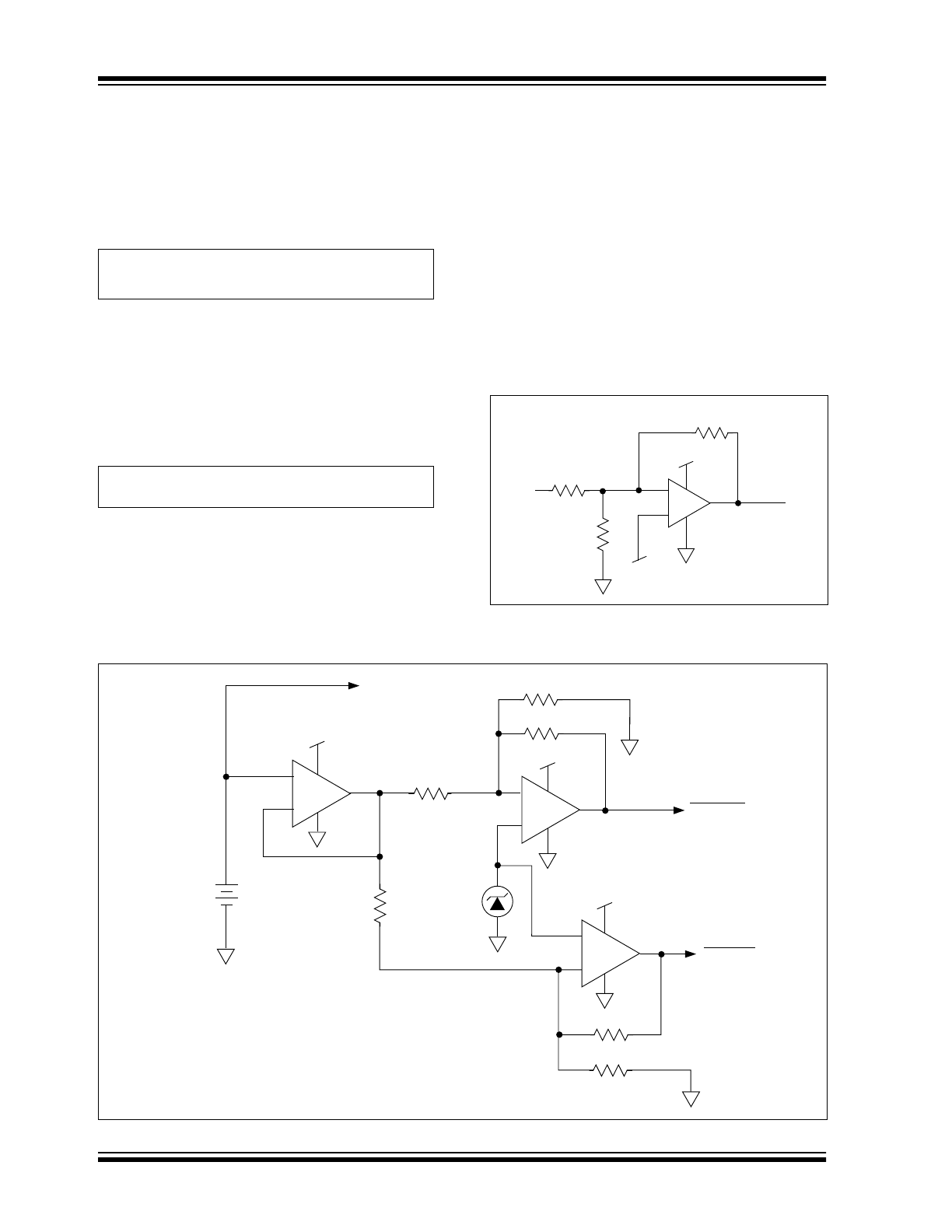
TC1027
DS21284B-page 6
2002 Microchip Technology Inc.
Capacitor C1 will charge up through R4. When the
voltage at the comparator’s inverting input is equal to
V
H
, the comparator output will switch. With the output
at ground potential, the value at the non-inverting input
terminal (V
L
) is reduced by the hysteresis network to a
value given by:
EQUATION 4-7:
Using the same resistors as before, capacitor C1 must
now discharge through R4 toward ground. The output
will return to a high state when the voltage across the
capacitor has discharged to a value equal to V
L
. The
period of oscillation will be twice the time it takes for the
RC circuit to charge up to one half its final value. The
period can be calculated from:
EQUATION 4-8:
The frequency stability of this circuit should only be a
function of the external component tolerances.
Figure 4-6 shows the circuit for a pulse width modulator
circuit. It is essentially the same as in Figure 4-4, but
with the addition of an input control voltage. When the
input control voltage is equal to one-half V
DD
, operation
is basically the same as described for the free-running
oscillator. If the input control voltage is moved above or
below one-half V
DD
, the duty cycle of the output square
wave will be altered. This is because the addition of the
control voltage at the input has now altered the trip
points. The equations for these trip points are shown in
Figure 4-6 (see V
H
and V
L
).
Pulse width sensitivity to the input voltage variations
can be increased by reducing the value of R6 from
10k
Ω
and conversely, sensitivity will be reduced by
increasing the value of R6. The values of R1 and C1
can be varied to produce the desired center frequency.
FIGURE 4-1:
COMPARATOR
EXTERNAL HYSTERESIS
CONFIGURATION
FIGURE 4-2:
PRECISION BATTERY MONITOR
V
L
V
DD
3
-----------
=
1
FREQ
-----------------
2 0.694
(
)
R4
(
)
C1
(
)
=
+
–
V
R
V
DD
V
OUT
V
SRC
R
A
R
B
R
C
1/4
TC1027
V
DD
V
DD
V
DD
R2, 330k, 1%
TC1034
1/4
R4, 470k, 1%
R5, 7.5M
1/4
R6, 7.5M
R3, 470k, 1%
R1, 270k, 1%
VR
To System DC/DC
Converter
3V
Alkaline
TC1027
BATTFAIL
BATTLOW
CMPTR1
+
–
CMPTR2
+
–
AMP1
+
–
+
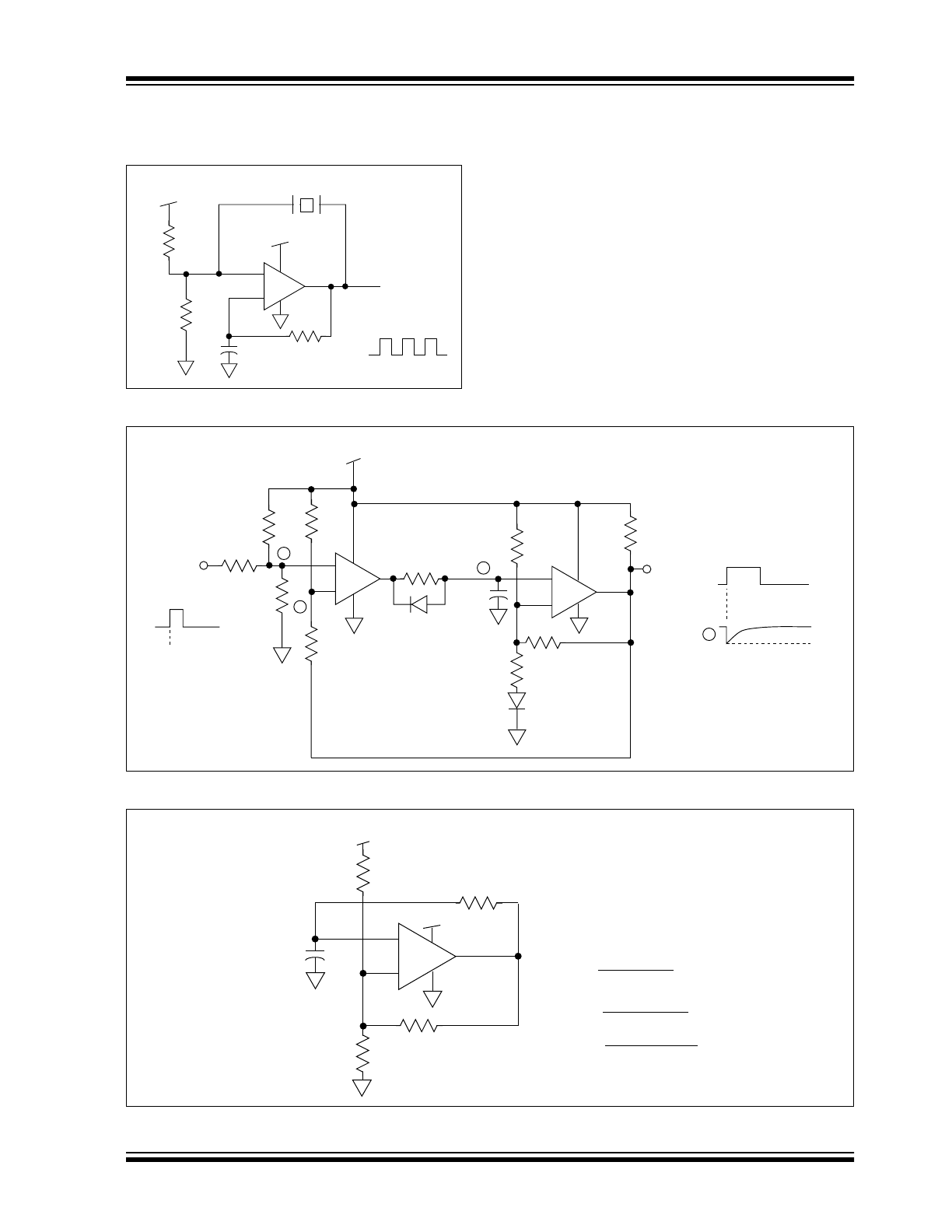
2002 Microchip Technology Inc.
DS21284B-page 7
TC1027
FIGURE 4-3:
32.768 kHz “TIME OF
DAY” CLOCK
OSCILLATOR
FIGURE 4-4:
NON-RETRIGGERABLE MULTIVIBRATOR
FIGURE 4-5:
SQUARE WAVE GENERATOR
+
V
DD
V
OUT
V
DD
RB
150k
RA
150k
R
C
1M
CA
100pF
32.768kHz
V
per
= 30.52
µsec
1/4
TC1027
–
+
–
+
–
V
DD
CMPTR1
CMPTR2
IN
IN
OUT
OUT
R3
1M
R4
1M
R6
562k
R7
1M
R2
100k
R1
100k
R8
D2
D1
10M
R9
243k
R5
10M
C1
100pF
R10
61.9k
A
B
C
GND
t
0
C
GND
V
DD
GND
V
DD
TC1025
TC1027
+
–
R1
100k
V
DD
R4
V
DD
R3
100k
R2
100k
C1
V
H
=
R2 (V
DD
)
R2 + (R1||R3)
V
L
=
(V
DD
) (R2||R3)
R1 + (R2||R3)
FREQ =
1
2(0.694)(R4)(C1)
1/4
TC1027
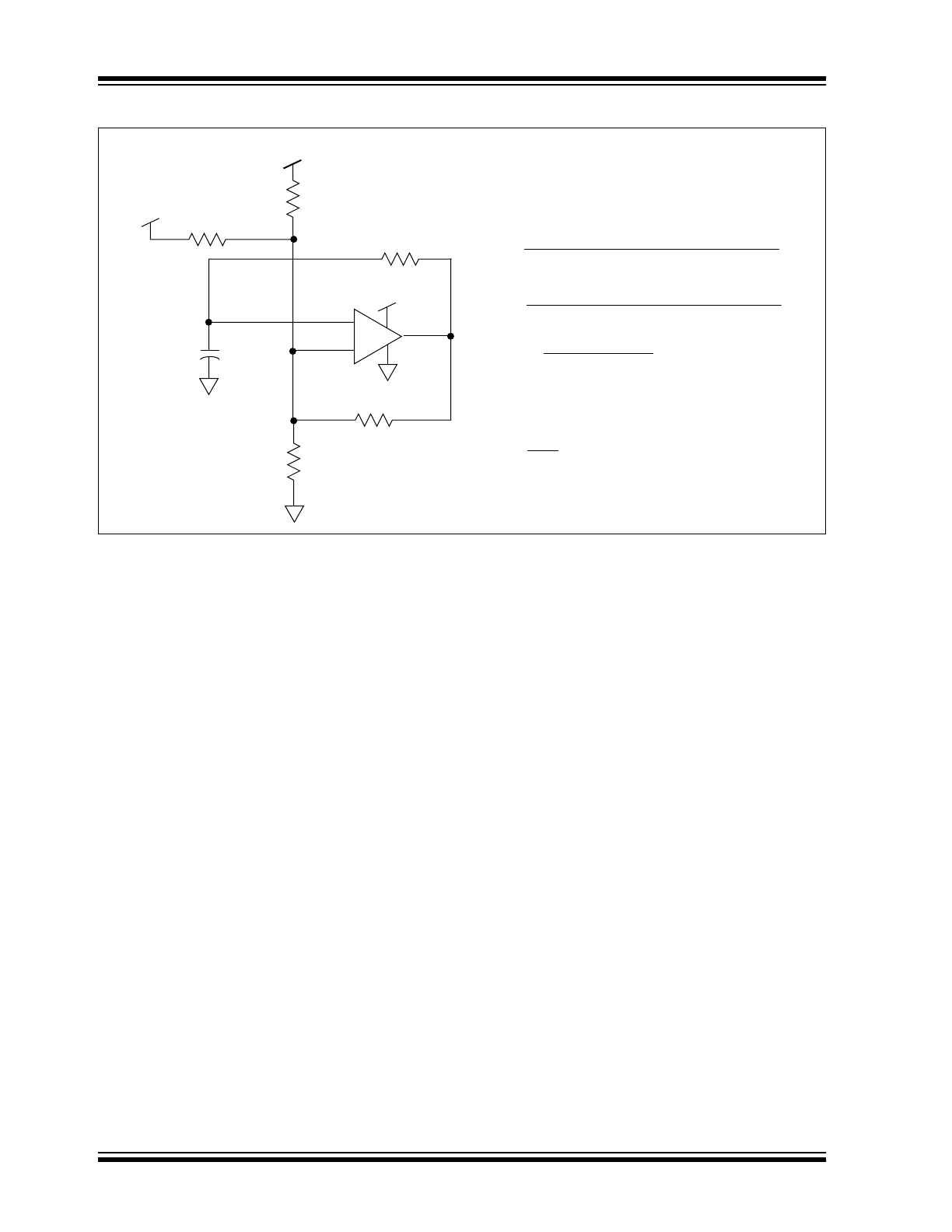
TC1027
DS21284B-page 8
2002 Microchip Technology Inc.
FIGURE 4-6:
PULSE WIDTH MONITOR
+
–
R6
10k
R4
V
C
V
DD
V
DD
R1
100k
R3
100k
R2
100k
C1
FREQ =
1
2
2 (0.694) (R4) (C1)
For Square Wave Generation
Select R1 = R2 = R3
TC1027
V
H
=
V
C
=
V
DD
V
DD
(R1R2R6 + R2R3R6) + V
C
(R1R2R3)
R1R2R6 + R1R3R6 + R2R3R6 + R1R2R3
V
DD
(R2R3R6) + V
C
(R1R2R3)
R1R2R6 + R1R3R6 + R2R3R6 + R1R2R3
V
L
=
1/4
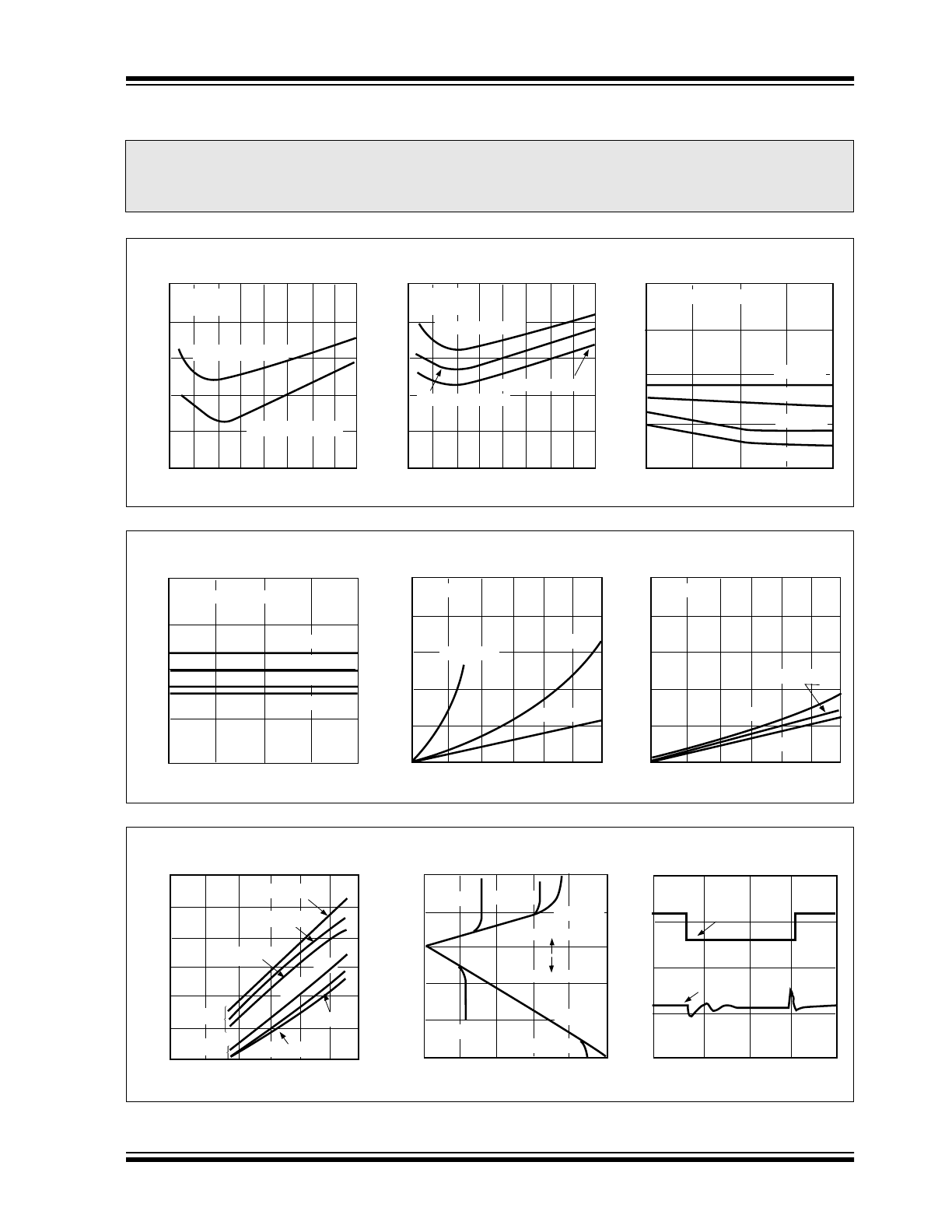
2002 Microchip Technology Inc.
DS21284B-page 9
TC1027
5.0
TYPICAL CHARACTERISTICS
Note:
The graphs and tables provided following this note are a statistical summary based on a limited number of
samples and are provided for informational purposes only. The performance characteristics listed herein
are not tested or guaranteed. In some graphs or tables, the data presented may be outside the specified
operating range (e.g., outside specified power supply range) and therefore outside the warranted range.
7
6
5
4
3
2
1.5
2
2.5
3
3.5
4
4.5
5
5.5
SUPPLY VOLTAGE (V)
SUPPLY VOLTAGE (V)
Comparator Propagation Delay
vs. Supply Voltage
DELAY TO RISING EDGE (
µ
sec)
Overdrive = 10mV
Overdrive = 50mV
7
6
5
4
3
2
1.5
2
2.5
3
3.5
4
4.5
5
5.5
DELAY TO FALLING EDGE (
µ
sec)
7
6
5
4
3
-40
°C
85
°C
25
°C
TEMPERATURE (
°C)
DELAY TO RISING EDGE (
µ
sec)
Overdrive = 100mV
Overdrive = 10mV
Overdrive = 50mV
Comparator Propagation Delay
vs. Supply Voltage
Comparator Propagation Delay
vs. Temperature
T
A
= 25°C
C
L
= 100pF
T
A
= 25°C
C
L
= 100pF
Overdrive = 100mV
V
DD
= 4V
V
DD
= 5V
V
DD
= 2V
V
DD
= 3V
-40
°C
85
°C
25
°C
2.5
2.0
1.5
1.0
.5
0
0
1
2
3
4
5
6
V
DD
- V
OUT
(V)
I
SOURCE
(mA)
7
6
5
4
3
Comparator Output Swing
vs. Output Source Current
DELAY TO FALLING EDGE (
µ
sec)
Overdrive = 100mV
2.5
2.0
1.5
1.0
.5
0
0
1
2
3
4
5
Comparator Propagation Delay
vs. Temperature
Comparator Output Swing
vs. Output Sink Current
TEMPERATURE (
°C)
I
SINK
(mA)
V
DD
= 4V
V
DD
= 5V
V
DD
= 2V
V
DD
= 3V
T
A
= 25°C
T
A
= 25°C
V
DD
= 3V
V
DD
= 1.8V
V
DD
= 5.5V
V
DD
= 3V
V
DD
= 1.8V
V
DD
= 5.5V
V
OUT
- V
SS
(V)
6
60
50
Sinking
40
30
20
10
0
0
1
2
3
4
5
6
OUTPUT SHORT-CIRCUIT CURRENT (mA)
SUPPLY VOLTAGE (V)
Comparator Output Short-Circuit
Current vs. Supply Voltage
Sourcing
T
A
= -40
°C
T
A
= -40
°C
T
A
= 25
°C
T
A
= 85
°C
T
A
= 25
°C
T
A
= 85
°C
REFERENCE VOLTAGE (V)
1.240
1.220
1.200
1.180
1.160
1.140
0
2
4
6
8
10
LOAD CURRENT (mA)
Reference Voltage vs.
Load Current
V
DD
= 1.8V
V
DD
= 3V
V
DD
= 5.5V
Sinking
Sourcing
V
DD
= 1.8V
V
DD
= 3V
V
DD
= 5.5V
4
3
2
1
0
0
100
200
300
400
SUPPLY AND REFERENCE VOLTAGES (V)
TIME (
µsec)
Line Transient
Response of V
REF
V
DD
V
REF
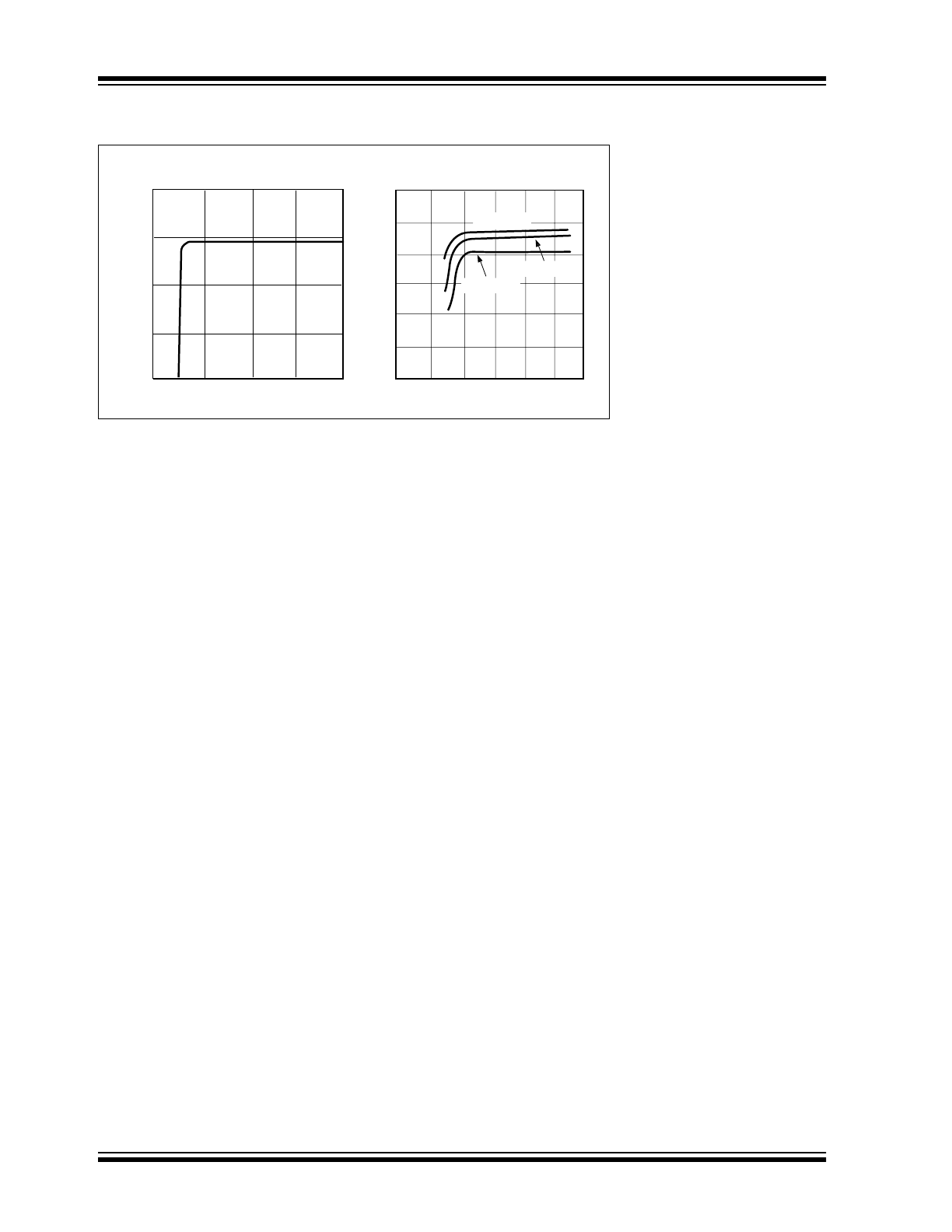
TC1027
DS21284B-page 10
2002 Microchip Technology Inc.
5.0
TYPICAL CHARACTERISTICS (CONTINUED)
1.25
1.20
1.15
1.10
1.05
1
2
3
4
5
REFERENCE VOLTAGE (V)
0
1
2
3
4
5
6
SUPPLY CURRENT
(µ
A)
SUPPLY VOLTAGE (V)
Supply Current vs. Supply Voltage
T
A
= 85
°C
20
18
16
14
12
10
8
T
A
= -40
°C
T
A
= 25
°C
Reference Voltage
vs. Supply Voltage
SUPPLY VOLTAGE (V)
